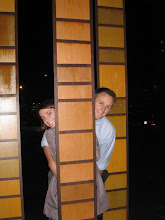My company pays me to find creative ways to build healthy workplace cultures through behavior change. To use Dominic's language, this is a 'pretty sweet gig'. I, like most people, have plenty of unhealthy behaviors I'm trying to change so I often try out new ideas in my own life before incorporating them into my client's toolkits and programming plans. One trial was so interesting I thought I'd write about it here for your own enjoyment.
Dr. BJ Fogg, Stanford professor and author of
Persuasive Technology, kept coming up in conversation. I had intended to read his book last September for book club, he was interviewed on
a radio program more than a year ago, and to be honest he had been on my mind last week as I'm quickly realizing I really need to get my act together in preparation for graduate school. Dr. Fogg believes in changing behavior by creating tiny habits. The process is fairly straight forward and I thought it would be helpful to experience the approach for myself this week.
I enrolled online last Friday and spent this week honing my tiny habits. So far I'm two for three. A tiny habit is: something you do at least once a day, something that takes you less than 30 seconds to complete, and something that requires little effort. Mine were:
- After taking off my work clothes do two pushups
- After getting in the car say a prayer
- After answering the phone stand up
I'll admit, mine aren't great. I never remembered to do the pushups (my one failure this week) and I couldn't remember to say a prayer when I got in the car
after work, only before.
Here are some other examples that are probably better.
I was initially quite attracted to the 'something that requires little effort' description. Dr. Fogg writes: "The easier the behavior, the less it depends on motivation". Wise words considering we all know how reliable motivation can be. He goes on to explain that the habit should be
on schedule. The new habit should come directly after an existing habit. He calls the existing habit an anchor and instructs us to always use an existing anchor to trigger the new tiny behavior we want. Another important requirement is to celebrate successes. He suggests saying 'victory' to ourselves not only when we do the behavior but also when we think of doing the behavior. I kept finding myself saying yes and jolting my elbow back like I've done since I was in first grade. Whatever works.
I'm going to keep trying to work on these tiny habits because the payoff could be big. If I'm already standing when I answer the phone, chances are I'll stay standing during the entire conversation. If I can do two pushups, chances are I'll stay down there to do 10 more. You see where this is going.
Curious? Try it
here, or just follow some of Dr. Fogg's thoughts
here.
